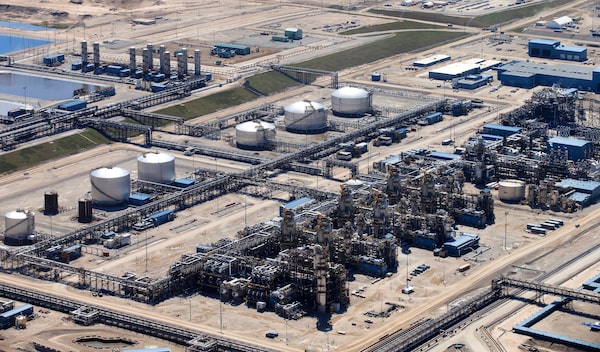
Imperial Oil's Kearl Oil Sands project plant near Fort McMurray, Alta. on June 13, 2017.Larry MacDougal/The Canadian Press
Athabasca Chipewyan First Nation will on Tuesday push a climate resolution at Imperial Oil Ltd.’s IMO-T annual meeting, the latest step in its public pressure on the oil giant, which failed to tell the community about a leaking oil sands tailings pond for almost a year.
Water tainted with dangerous levels of arsenic, dissolved metals and hydrocarbons seeped from the Kearl oil sands project in Northern Alberta into the environment for more than a year starting in May, 2022, but no local communities were told until a separate incident in February, 2023, spilled 5.3 million litres of wastewater.
The leak and the secrecy around it spurred numerous investigations, including by the House of Commons environment committee, and prompted Imperial’s chief executive officer to apologize. ACFN is also suing the Alberta Energy Regulator.
Chief Allan Adam said ACFN is taking the unusual step of applying pressure at Imperial’s meeting because the Calgary-based company has done nothing to prove to his community that the Kearl oil sands project is safe.
Imperial posts regular updates on work under way to address industrial wastewater leaking from its site. In its April update, it said its focus is on expanding and improving its seepage interception system and monitoring network. That includes more than tripling the number of pumping and monitoring wells as part of plans to expand the system.
While ACFN’s resolution is specific to Imperial, Mr. Adam said its target is much broader.
“This is going out to all of industry, putting all of industry on notice,” he said in an interview. “It pertains to every company in the region that has a tailings pond.”
The two-line resolution, moved on behalf of shareholder Leanne Baer, doesn’t directly refer to Kearl, nor the tailings leak. Instead, it requests that the board provide an audited report within a year estimating the financial effects of climate change on Imperial’s asset retirement obligations. Those obligations, it argues, could pose a financial material risk to the oil company, and thus should be disclosed to shareholders.
In its rationale for the resolution, ACFN argues that understanding the energy transition’s financial consequences on oil and gas companies is essential information for investors, and critical for making informed decisions related to the financial health of the company.
“This is particularly the case for a company like Imperial, whose flagship asset – Kearl – is projected by the company to still be producing into the 2060s or even later,” it wrote.
“The leak and the company’s failure to inform impacted communities, for which Imperial’s CEO had to apologize before the Canadian Parliament, raise serious questions about Imperial’s ability to manage the risk of long-liability assets like tailings ponds as well as its commitment to transparency.”
It said the company fails to provide its shareholders with sufficient information on risks tied to climate transition and future environmental cleanup, particularly because Imperial has long-life oil projects with high reclamation costs, which make the company vulnerable.
Providing the data would help rebuild trust with communities that are downstream of the oil sands operations, “whose goodwill is critical to the company’s license to operate,” ACFN said.
Imperial Oil urged its shareholders to reject the resolution, citing a corporate target of reducing emissions intensity by 30 per cent from 2016 levels by 2030. It also aims to achieve net-zero emissions by 2050, although that target does not include Scope 3 emissions – those from the end use of its petroleum products, which make up the largest proportion.
It said in its management proxy circular it employs planning scenarios developed by third parties to stress-test its assets for such energy-transition factors as implementation of low-carbon sources. But it warned that these are “hypothetical constructs and are highly sensitive to assumptions that will change in the future.” Key unknowns include yet-to-be-developed government policies, market conditions and advances in technology that may influence the cost, pace and potential availability of certain pathways.
With regard to future environmental liabilities, Imperial said it records the fair value of future obligations on its balance sheet, factoring in such things as legal obligations, technical assessments as well as discount and inflation rates. According to the company’s 2023 annual report, it had $2.56-billion in long-term asset retirement liabilities at the end of the year, up from $2.15-billion the year before.
“Calculating asset retirement obligations as per the resolution presented would produce a set of arbitrary, uncertain and hypothetical views of the future rather than the thoughtful, fact-based approach used to produce asset retirement obligation estimates that are aligned with legal and regulatory requirements,” the company said.